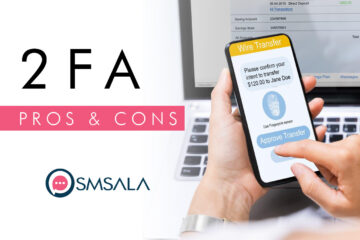When it comes to customer authentication, organizations today face the growing challenge of providing secure access while maintaining a seamless user experience. Among the numerous methods available, Voice OTP (One-Time Password) has risen to prominence as an increasingly reliable alternative to traditional forms of verification. With cybersecurity threats on the rise and the demand for secure yet simple solutions increasing, Voice OTP is carving a new path toward better customer authentication. In this article, we’ll explore how Voice OTP can enhance the authentication process, why it’s becoming a go-to choice for IT professionals, cybersecurity experts, and telecom engineers, and how companies like SMSala are simplifying the process globally for millions of users.

What is Voice OTP and How Does it Work?
Voice OTP is a form of multi-factor authentication (MFA) that delivers a one-time password via a phone call rather than a traditional text message or email. This method adds an additional layer of security, ensuring that even if a user’s credentials are compromised, they still must authenticate via a phone call. It works by generating a unique OTP, which is then spoken to the user over the phone in a secure, audibly conveyed format. This system is especially useful for customers in regions where SMS delivery may be unreliable, ensuring that access can still be granted without sacrificing security.
Unlike SMS-based OTP, which relies on the security of the text message protocol, Voice OTP uses a phone call—often perceived as a more reliable and secure method. The concept is similar to other MFA mechanisms, such as using an app like Google Authenticator, but it focuses on a medium that users are inherently familiar with and may trust more for verification.
Key Benefits of Voice OTP for Customer Authentication
-
Enhanced Security
Voice OTP is a strong contender for secure authentication because it circumvents several common vulnerabilities of SMS-based OTPs. For instance, SMS messages can be intercepted through SIM swapping or network vulnerabilities. Since Voice OTPs are transmitted over voice calls, they are inherently more difficult to intercept compared to SMS messages. As a result, this form of authentication provides better protection against certain types of attacks. -
Broader Accessibility
One of the key advantages of Voice OTP is its ability to reach a broader audience. In many regions, users may not have access to smartphones or data plans that support the delivery of SMS. Voice OTP can be delivered to any phone number, including landlines, which increases its reach and accessibility for all users, even those in remote or underserved areas. -
Reduced Risk of Phishing Attacks
Phishing is a significant concern in the realm of digital security, and many people are familiar with the risks associated with fake websites or messages that prompt them to enter sensitive information. Voice OTP mitigates this risk by ensuring that the OTP is only heard by the intended recipient. This is a much harder vector for phishing schemes to exploit compared to text-based OTPs, where users might be tricked into entering their codes on malicious sites. -
Improved User Experience
With voice-based authentication, the user doesn’t need to rely on typing in a complex code manually, reducing errors or frustration. The voice prompt is often simpler to follow, ensuring that even users unfamiliar with digital security processes can complete authentication quickly and accurately. -
Global Reach with SMSala’s Services
Global messaging providers like SMSala offer Voice OTP services through their APIs, allowing businesses to easily integrate voice-based authentication into their existing systems. With over 5000 enterprise customers worldwide, SMSala’s platform ensures that Voice OTP can be deployed at scale across regions, providing businesses with a robust and effective solution for customer verification.
Why Voice OTP Is Gaining Popularity in Customer Authentication
As digital threats evolve, traditional authentication methods, like password-based systems, are no longer enough to protect sensitive data. Voice OTP has emerged as an attractive alternative to address these concerns due to several factors:
1. Growing Cybersecurity Risks
As more organizations shift to cloud-based platforms and digital services, the risk of cyberattacks, including data breaches and identity theft, increases. Voice OTP adds an additional layer of security to ensure that even if an attacker gains access to a user’s credentials, they cannot complete the authentication without access to the user’s phone.
2. Regulatory Pressure
Governments around the world are tightening regulations around data security and authentication. For instance, the European Union’s GDPR mandates that companies implement strong measures to secure customer data. In some regions, the use of multi-factor authentication (MFA) has become a requirement for financial institutions and other high-risk industries. Voice OTP is a flexible and effective way to meet these regulatory demands without compromising user experience.
3. User Convenience
With the increasing adoption of mobile phones across the globe, users are looking for authentication methods that do not burden them with extra steps. Voice OTP allows users to authenticate in a straightforward manner, often without needing to interact with a device beyond answering a call. This simplicity is appealing, especially for non-technical users.
4. Telecom Advancements
As telecom infrastructure improves globally, the reliability of voice services has also improved, making Voice OTP a more dependable option for authentication. Innovations in technologies like 5G and advanced VoIP systems contribute to more efficient and faster delivery of voice-based OTPs.
Real-World Examples of Voice OTP in Action
To understand the practical benefits of Voice OTP, let’s explore a few real-world examples where this technology is already in use.
-
Financial Services
Banks and fintech companies around the world are increasingly adopting Voice OTP to verify transactions and account access. In countries with large rural populations, Voice OTP provides a way for customers to authenticate their identity without needing an internet connection or smartphone. For instance, a user attempting to transfer funds via their bank’s mobile app may receive a voice call with a one-time code that they need to repeat to complete the transaction. -
Telecommunications Providers
Telecom companies can use Voice OTP for customer account management, including password resets, service activation, and billing inquiries. By adding this extra layer of verification, telecom providers can prevent unauthorized access to customer accounts, reducing fraud and improving customer satisfaction. -
E-Commerce
E-commerce platforms use Voice OTP to protect user accounts and payment information. With increasing concerns about online fraud, e-commerce websites are turning to voice-based authentication to enhance their verification processes. A customer may receive a voice OTP during the checkout process to confirm their identity and ensure that their payment is valid.
How SMSala Simplifies Global Voice OTP for Customer Authentication
As businesses increasingly look for ways to implement Voice OTP on a global scale, SMSala plays a pivotal role. As a leader in messaging solutions, SMSala’s platform enables enterprises to send Voice OTPs to customers worldwide through a simple API integration. With a presence in over 150 countries and a robust infrastructure supporting both SMS and Voice OTPs, SMSala makes it easier for businesses to provide secure and reliable authentication services at scale.
How Telecom Engineers Can Leverage Voice OTP
Telecom engineers are at the forefront of ensuring that new technologies are integrated smoothly into existing infrastructure. With Voice OTP, telecom engineers can help develop secure and cost-effective customer authentication systems. By partnering with platforms like SMSala, telecom providers can integrate Voice OTP seamlessly into their messaging workflows, improving security for their clients.
Additionally, telecom engineers can leverage their understanding of telecommunication protocols to ensure that voice calls delivering OTPs are routed through the most efficient and secure channels. By doing so, they can enhance the overall user experience and provide customers with a reliable and fast method for authentication.
Conclusion: Why Voice OTP is the Future of Customer Authentication
Voice OTP is quickly becoming a go-to method for secure customer authentication. Whether you’re an IT professional, a cybersecurity expert, or a telecom engineer, this technology offers an effective solution to combat cyber threats while improving the customer experience. By providing an alternative to traditional SMS-based verification methods, Voice OTP helps secure access to sensitive accounts and transactions, making it a key component of any modern authentication strategy.
As businesses increasingly rely on messaging providers like SMSala to deploy Voice OTP at scale, the adoption of this technology will continue to grow. With its accessibility, enhanced security, and ability to reduce the risk of phishing attacks, Voice OTP is poised to play a major role in the future of customer authentication.


